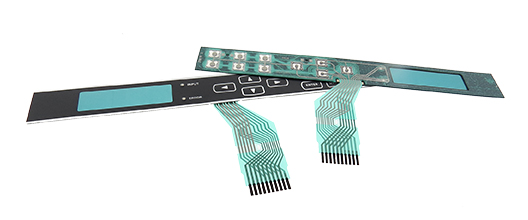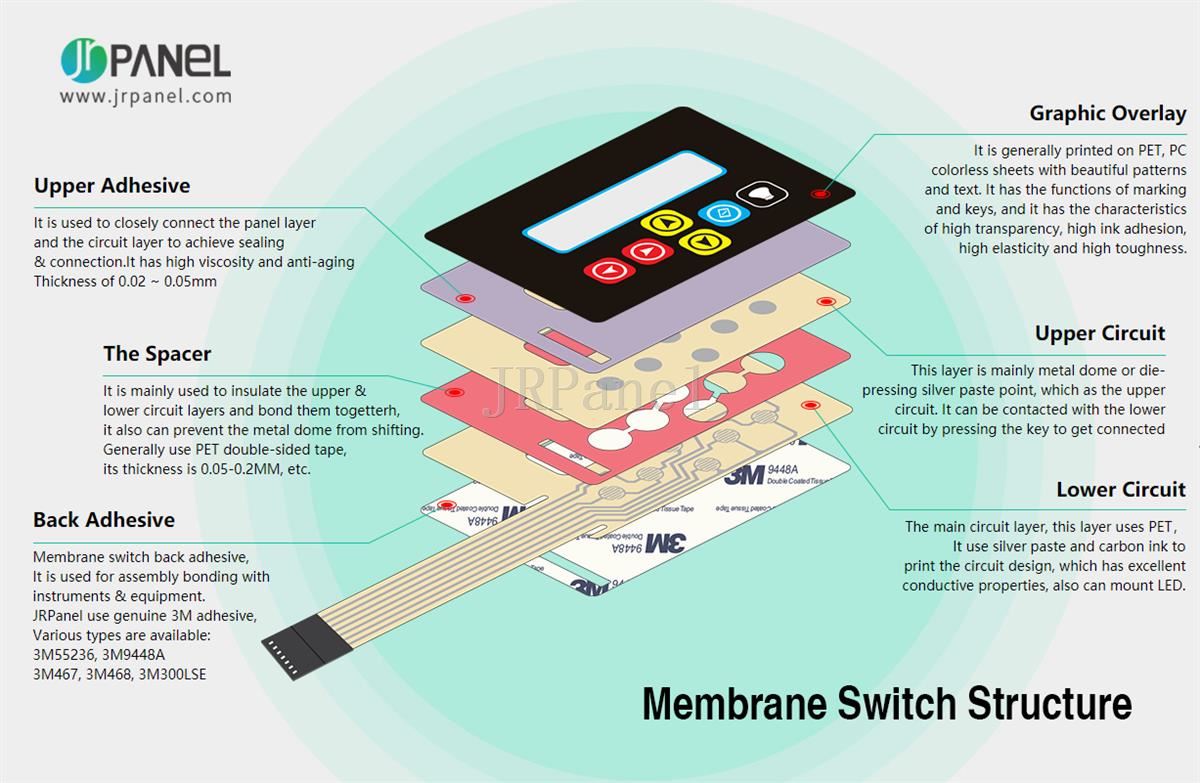The Manufacturing Refine Behind Membrane Change: What You Required to Know
The manufacturing procedure behind membrane changes combines mindful style, product selection, and quality control. It starts with comprehending the intricacies of membrane layer button style and advances via different stages, including product options and printing methods. Each stage plays an important duty in guaranteeing functionality and toughness. The complexities of layer construction and the extensive screening criteria might reveal insights that are not right away apparent. What lies past these fundamental components?
Understanding Membrane Layer Change Style
Membrane layer buttons might appear basic at first glance, their layout includes detailed considerations that guarantee capability and durability. The style procedure starts with a complete understanding of user requirements, including the interface's intended application and ecological variables. Ergonomics is a vital component, as the format has to assist in ease of use while making certain that tactile feedback fulfills individual expectations.Moreover, the layering of parts, such as graphic overlays, sticky layers, and conductive traces, have to be specifically engineered. membrane switch. This split setup not just influences the button's responsiveness however additionally influences its longevity. Interest is offered to the sealing methods utilized to safeguard versus moisture and dust, which might endanger performance. Additionally, design considerations include visual appeals, where color schemes and visual clearness improve customer experience. Inevitably, the layout of membrane layer changes balances capability, user experience, and toughness, making certain that they meet the demands of numerous applications effectively
Materials Utilized in Membrane Switch Production
When selecting materials for membrane layer button production, it is important to contemplate both efficiency and longevity. The key products consist of polyester and polycarbonate films, which provide adaptability and toughness. These films are typically coated with sticky to guarantee appropriate bonding to substratums. Conductive inks, normally composed of silver or carbon, are critical for creating electric links within the button, permitting trustworthy operation.Additionally, a safety layer, such as a tough coat, is often used to enhance scrape resistance and durability. The choice of backing product, such as acrylic or foam, can considerably influence the switch's responsive feel and overall user experience. Different ecological elements, consisting of temperature level and humidity, should direct material selection to assure peak performance in specific applications. Inevitably, the right combination of products adds to the membrane layer switch's capability and life-span, making notified choices vital for producers.
The Printing Refine: Creating Video and Text
The printing process in membrane layer switch production plays a considerable role in creating premium graphics and message. Different visuals design methods are employed to ensure aesthetic appeal and performance, while cautious ink choice approaches are essential for longevity and performance. Recognizing these elements is essential for accomplishing ideal results in membrane layer button design.
Graphic Design Techniques
Graphic style strategies play an essential role in the printing process of membrane layer switches, as they define how graphics and message will inevitably show up on the last item. Reliable visuals style entails the tactical usage of formats, fonts, and shades to improve readability and visual allure. Developers commonly make use of vector graphics for scalability, ensuring that photos stay sharp at different sizes. In addition, interest to comparison and placement is essential, as it influences customer communication and aesthetic top quality. The consolidation of branding elements, such as logo designs, must be taken care of with treatment to maintain brand honesty. Generally, thoughtful graphic layout techniques contribute considerably to the capability and good looks of membrane buttons, impacting customer experience and item efficiency.
Ink Option Techniques
Selecting the ideal ink is necessary for accomplishing the desired aesthetic top quality and toughness in membrane button production. Different ink kinds are made use of, consisting of solvent-based, water-based, and UV-curable inks. Each type supplies distinctive attributes, such as adaptability, resistance, and adhesion to ecological variables. Solvent-based inks are typically preferred for their sturdiness and lively shades, while water-based inks are more eco-friendly yet might have constraints in attachment. UV-curable inks provide rapid treating and robust efficiency. In addition, color matching methods ensure that the selected inks straighten with style specs. Ultimately, the option of ink should consider aspects such as application technique, substratum compatibility, and end-use needs to accomplish exceptional cause membrane layer switch graphics and message.
Layer Construction and Setting Up

Product Selection Process
A careful option of products is necessary in the production process of membrane layer buttons, as it straight influences performance and longevity. The main products made use of include polyester, polycarbonate, and numerous conductive inks. Polyester is frequently favored for its outstanding resistance to chemicals and abrasion, making it suitable for extreme environments. Polycarbonate, on the other hand, supplies remarkable quality and effect resistance, which is beneficial for applications needing presence and robustness. Conductive inks, usually made up of silver or carbon, are essential for developing trusted electric paths. Additionally, the selection of sticky materials impacts the overall stability of the switch - membrane switch. Reviewing variables such as ecological exposure, responsive responses, and aesthetic needs guides suppliers in choosing the very best products for their certain applications
Layer Adhesion Techniques
Sticking layers in membrane layer switch construction is a crucial process that assures performance and long life. Numerous attachment methods are employed to secure excellent bonding between layers, which generally include using adhesives, warmth, and stress. Pressure-sensitive adhesives (PSAs) are commonly used for their simplicity of application and prompt bonding capabilities. Furthermore, thermal bonding methods can be applied, where warm is used to turn on glue homes, securing a solid bond. The choice of adhesion method mainly depends upon the products entailed and the details application demands of the membrane layer button. Correct placement and uniform application of adhesives are vital to avoid problems, protecting the switch runs effectively throughout its intended lifespan.
Quality Assurance Steps
Ensuring quality assurance throughout the layer building and setting up of membrane switches is necessary for keeping efficiency and integrity. This procedure usually involves numerous vital procedures, including detailed examinations at weblink each phase of production. Producers utilize advanced screening methods, such as peel tests and attachment evaluations, to validate the integrity of layer bonds. In addition, aesthetic examinations are conducted to determine any defects in printing or material variances. Environmental problems, such as temperature and moisture, are meticulously kept an eye on to guarantee ideal healing and adhesion. Regular calibration of devices helps preserve accurate production standards. By carrying out these quality control actions, makers can considerably reduce the danger of item failing, guaranteeing that the final membrane switches over meet the called for specifications and customer expectations.
Checking and Quality Assurance Steps

Innovations in Membrane Layer Change Innovation
As advancements in modern technology remain to evolve, membrane switches are taking advantage of ingenious advancements that boost their capability and individual experience. One remarkable technology is the combination of capacitive touch modern technology, which enables even more user-friendly and receptive customer interfaces. This shift not only improves visual appeals yet also lowers mechanical damage, expanding the life expectancy of the switches.Additionally, innovations in graphic overlay products have caused boosted longevity and resistance to environmental elements such as moisture and UV light. These products currently offer enhanced clarity and illumination, further elevating the visual appeal.Furthermore, the unification of clever innovation is changing membrane changes into interactive control panels, making it possible for connection with IoT tools. This connection promotes a seamless individual experience, leading the way for applications in different sectors, from healthcare to customer electronic devices. Jointly, these advancements position membrane layer switches as critical parts in contemporary gadget design.
Regularly Asked Concerns
How much time Does the Membrane Change Manufacturing Refine Take?
The period of the membrane button production procedure can differ significantly. Variables such as complexity, products made use of, and production quantity influence timelines, with regular manufacturing ranging from a couple of days to several weeks for conclusion.
What Are the Typical Applications for Membrane Layer Buttons?
Membrane layer buttons are frequently used in numerous industries, consisting of automotive controls, home devices, clinical gadgets, and customer electronics (membrane switch). Their convenience and longevity make them optimal for applications calling for straightforward interfaces and trustworthy efficiency in varied environments
Can Membrane Changes Be Customized for Specific Needs?

What Is the Life-span of a Typical Membrane Change?
The life-span of a typical membrane switch varies, however usually, it varies from 1 to 5 million cycles. Factors such as usage, environment, and material high quality substantially affect resilience and general performance gradually.

Are Membrane Switches Eco-friendly?
The ecological kindness of membrane layer changes varies. Some materials used might not be recyclable, while others can be green. The total effect depends upon producing practices and materials, requiring careful consideration throughout choice and disposal. The manufacturing process behind membrane layer changes combines cautious design, product choice, and quality control. It begins with comprehending the complexities of membrane layer button design and proceeds via various phases, including material selections and printing methods. When selecting products for membrane button manufacturing, it is essential to ponder both performance and resilience. A mindful choice of materials is necessary in the manufacturing procedure of membrane buttons, as it directly affects performance and durability. The option of adhesion approach mostly depends on the products involved and the details application requirements of the membrane layer switch.